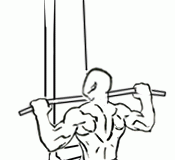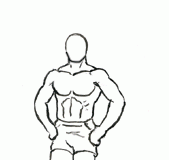Last Updated on February 13, 2025
The Squat to Bench with Dumbbells is an excellent lower body exercise that targets the quadriceps, hamstrings, glutes, and core muscles. This variation incorporates a bench to help you gauge the depth of your squat, ensuring proper form and preventing injury. It is especially useful for beginners who are learning to squat correctly, as well as for experienced lifters looking to refine their technique.
Benefits of Squat to Bench with Dumbbells
- Improved Squat Depth: The bench acts as a guide, encouraging you to lower yourself to an appropriate depth.
- Enhanced Stability: Holding dumbbells provides balance and engages your core.
- Muscle Activation: Works multiple muscle groups, including legs, glutes, and core.
- Safety: Reduces the risk of injury by promoting correct posture and depth.
Steps to Perform the Squat to Bench with Dumbbells
- Setup: Place a sturdy bench behind you. Make sure it is positioned in a way that allows you to touch it lightly when you lower yourself.
- Hold Dumbbells: Grasp a dumbbell in each hand, letting them hang naturally by your sides.
- Position Your Feet: Stand with your feet slightly wider than shoulder-width apart. Your toes and knees should be pointed slightly outward.
- Engage Your Core: Draw your abs in tightly to stabilize your torso throughout the movement.
- Begin the Descent: Slowly lower your body by bending at your knees and hips simultaneously. Push your hips back as if you are about to sit down.
- Controlled Movement: Lower yourself until your glutes lightly touch the bench. Do not sit down; the bench is just a guide.
- Balance Check: Ensure that your weight remains on your heels, not shifting towards your toes to prevent loss of balance.
- Pause and Rise: Pause briefly in the lowered position, then push through your heels to return to the starting position.
Tips for Perfecting the Squat to Bench with Dumbbells
- Practice First: Begin with bodyweight squats to get accustomed to the movement.
- Maintain an Upright Torso: Keep your chest up and shoulders back.
- Controlled Breathing: Inhale as you lower yourself, and exhale as you rise.
- Avoid Sitting Down: Lightly tap the bench with your glutes and immediately push back up.
Common Mistakes to Avoid
- Leaning Forward: This can strain your lower back and shift weight to your toes.
- Rushing the Movement: Perform the exercise slowly and with control.
- Knees Caving In: Keep your knees aligned with your toes.
Variations and Progressions
- Bodyweight Squat to Bench: For beginners, start without dumbbells.
- Goblet Squat to Bench: Hold a single dumbbell close to your chest.
- Pistol Squat to Bench: Perform the squat on one leg for an advanced challenge.
Incorporate the Squat to Bench with Dumbbells into your workout routine to build strength, improve balance, and enhance overall lower body muscle definition.






